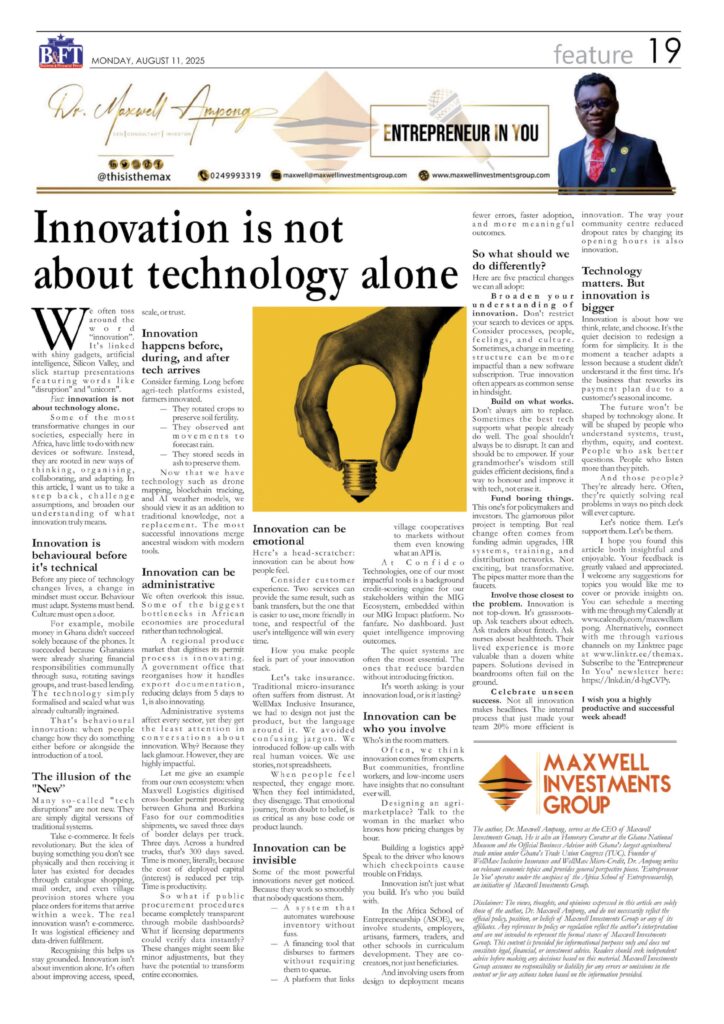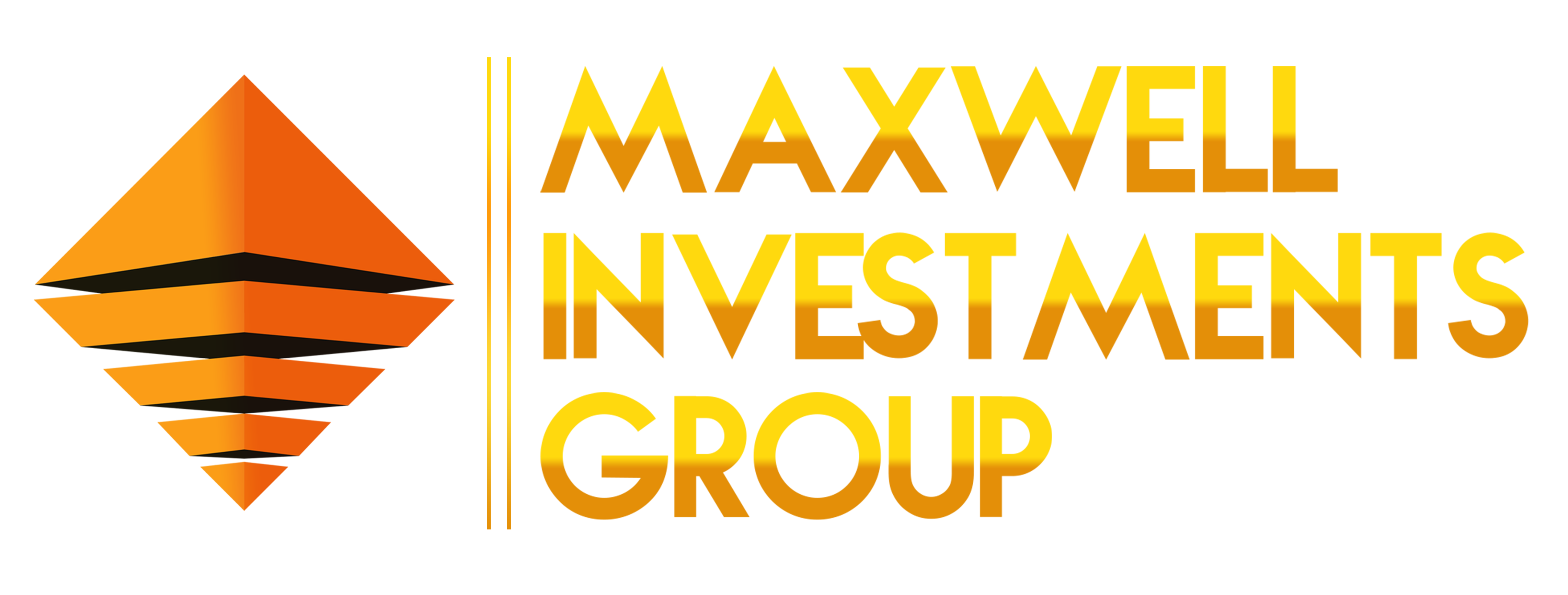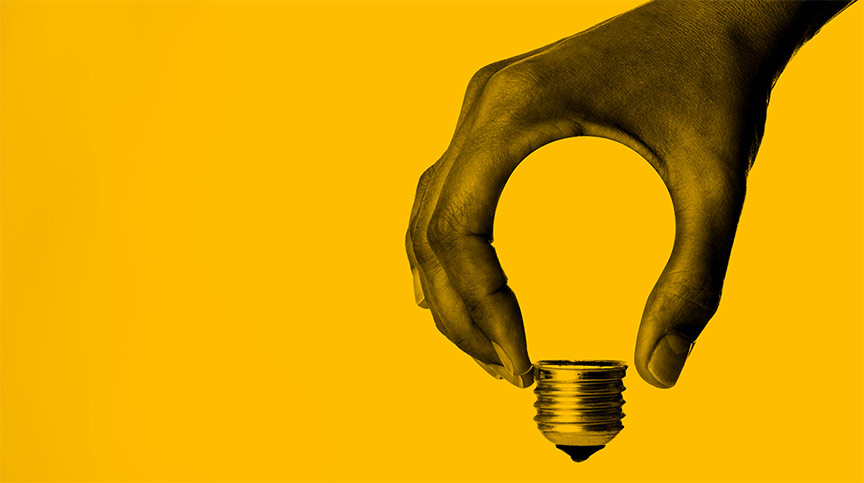
We often toss around the word “innovation”. It’s linked with shiny gadgets, artificial intelligence, Silicon Valley, and slick startup presentations featuring words like “disruption” and “unicorn”.
Fact: innovation is not about technology alone.
Some of the most transformative changes in our societies, especially here in Africa, have little to do with new devices or software. Instead, they are rooted in new ways of thinking, organising, collaborating, and adapting. In this article, I want us to take a step back, challenge assumptions, and broaden our understanding of what innovation truly means.
Innovation Is Behavioural Before It’s Technical
Before any piece of technology changes lives, a change in mindset must occur. Behaviour must adapt. Systems must bend. Culture must open a door.
For example, mobile money in Ghana didn’t succeed solely because of the phones. It succeeded because Ghanaians were already sharing financial responsibilities communally through susu, rotating savings groups, and trust-based lending. The technology simply formalised and scaled what was already culturally ingrained.
That’s behavioural innovation: when people change how they do something either before or alongside the introduction of a tool.
The Illusion of the “New”
Many so-called “tech disruptions” are not new. They are simply digital versions of traditional systems.
Take e-commerce. It feels revolutionary. But the idea of buying something you don’t see physically and then receiving it later has existed for decades through catalogue shopping, mail order, and even village provision stores where you place orders for items that arrive within a week. The real innovation wasn’t e-commerce. It was logistical efficiency and data-driven fulfilment.
Recognising this helps us stay grounded. Innovation isn’t about invention alone. It’s often about improving access, speed, scale, or trust.
Innovation Happens Before, During, and After Tech Arrives
Consider farming. Long before agri-tech platforms existed, farmers innovated.
- They rotated crops to preserve soil fertility.
- They observed ant movements to forecast rain.
- They stored seeds in ash to preserve them.
Now that we have technology such as drone mapping, blockchain tracking, and AI weather models, we should view it as an addition to traditional knowledge, not a replacement. The most successful innovations merge ancestral wisdom with modern tools.
Innovation Can Be Administrative
We often overlook this issue. Some of the biggest bottlenecks in African economies are procedural rather than technological.
A regional produce market that digitises its permit process is innovating.
A government office that reorganises how it handles export documentation, reducing delays from 5 days to 1, is also innovating.
Administrative systems affect every sector, yet they get the least attention in conversations about innovation. Why? Because they lack glamour. However, they are highly impactful.
Let me give an example from our own ecosystem: when Maxwell Logistics digitised cross-border permit processing between Ghana and Burkina Faso for our commodities shipments, we saved three days of border delays per truck. Three days. Across a hundred trucks, that’s 300 days saved. Time is money, literally, because the cost of deployed capital (interest) is reduced per trip. Time is productivity.
So what if public procurement procedures became completely transparent through mobile dashboards? What if licensing departments could verify data instantly? These changes might seem like minor adjustments, but they have the potential to transform entire economies.
Innovation Can Be Emotional
Here’s a head-scratcher: innovation can be about how people feel.
Consider customer experience. Two services can provide the same result, such as bank transfers, but the one that is easier to use, more friendly in tone, and respectful of the user’s intelligence will win every time.
How you make people feel is part of your innovation stack.
Let’s take insurance. Traditional micro-insurance often suffers from distrust. At WellMax Inclusive Insurance, we had to design not just the product, but the language around it. We avoided confusing jargon. We introduced follow-up calls with real human voices. We use stories, not spreadsheets.
When people feel respected, they engage more. When they feel intimidated, they disengage. That emotional journey, from doubt to belief, is as critical as any base code or product launch.
Innovation Can Be Invisible
Some of the most powerful innovations never get noticed. Because they work so smoothly that nobody questions them.
- A system that automates warehouse inventory without fuss.
- A financing tool that disburses to farmers without requiring them to queue.
- A platform that links village cooperatives to markets without them even knowing what an API is.
At Confideo Technologies, one of our most impactful tools is a background credit-scoring engine for our stakeholders within the MIG Ecosystem, embedded within our MIG Impact platform. No fanfare. No dashboard. Just quiet intelligence improving outcomes.
The quiet systems are often the most essential. The ones that reduce burden without introducing friction.
It’s worth asking: is your innovation loud, or is it lasting?
Innovation Can Be Who You Involve
Who’s in the room matters.
Often, we think innovation comes from experts. But communities, frontline workers, and low-income users have insights that no consultant ever will.
Designing an agri-marketplace? Talk to the woman in the market who knows how pricing changes by hour.
Building a logistics app? Speak to the driver who knows which checkpoints cause trouble on Fridays.
Innovation isn’t just what you build. It’s who you build with.
In the Africa School of Entrepreneurship (ASOE), we involve students, employers, artisans, farmers, traders, and other schools in curriculum development. They are co-creators, not just beneficiaries.
And involving users from design to deployment means fewer errors, faster adoption, and more meaningful outcomes.
So What Should We Do Differently?
Here are five practical changes we can all adopt:
Broaden your understanding of innovation. Don’t restrict your search to devices or apps. Consider processes, people, feelings, and culture. Sometimes, a change in meeting structure can be more impactful than a new software subscription. True innovation often appears as common sense in hindsight.
Build on what works. Don’t always aim to replace. Sometimes the best tech supports what people already do well. The goal shouldn’t always be to disrupt. It can and should be to empower. If your grandmother’s wisdom still guides efficient decisions, find a way to honour and improve it with tech, not erase it.
Fund boring things. This one’s for policymakers and investors. The glamorous pilot project is tempting. But real change often comes from funding admin upgrades, HR systems, training, and distribution networks. Not exciting, but transformative. The pipes matter more than the faucets.
Involve those closest to the problem. Innovation is not top-down. It’s grassroots-up. Ask teachers about edtech. Ask traders about fintech. Ask nurses about healthtech. Their lived experience is more valuable than a dozen white papers. Solutions devised in boardrooms often fail on the ground.
Celebrate unseen success. Not all innovation makes headlines. The internal process that just made your team 20% more efficient is innovation. The way your community centre reduced dropout rates by changing its opening hours is also innovation.
Technology matters. But innovation is bigger.
Innovation is about how we think, relate, and choose. It’s the quiet decision to redesign a form for simplicity. It is the moment a teacher adapts a lesson because a student didn’t understand it the first time. It’s the business that reworks its payment plan due to a customer’s seasonal income.
The future won’t be shaped by technology alone. It will be shaped by people who understand systems, trust, rhythm, equity, and context. People who ask better questions. People who listen more than they pitch.
And those people? They’re already here. Often, they’re quietly solving real problems in ways no pitch deck will ever capture.
Let’s notice them. Let’s support them. Let’s be them.
I hope you found this article both insightful and enjoyable.
Subscribe to the ‘Entrepreneur In You’ newsletter here: https://lnkd.in/d-hgCVPy.
I wish you a highly productive and successful week ahead!
♕ —- ♕ —- ♕ —- ♕ —- ♕
Disclaimer: The views, thoughts, and opinions expressed in this article are solely those of the author, Dr. Maxwell Ampong, and do not necessarily reflect the official policy, position, or beliefs of Maxwell Investments Group or any of its affiliates. Any references to policy or regulation reflect the author’s interpretation and are not intended to represent the formal stance of Maxwell Investments Group. This content is provided for informational purposes only and does not constitute legal, financial, or investment advice. Readers should seek independent advice before making any decisions based on this material. Maxwell Investments Group assumes no responsibility or liability for any errors or omissions in the content or for any actions taken based on the information provided.


